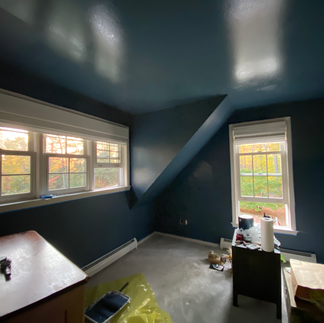A Big Boy Room: Designing a Space That Grows With Your Child
- Lindsey Reis
- May 12
- 3 min read
Updated: May 20

There’s a bittersweet magic in watching your child outgrow their nursery. As an interior designer and a mom, this transition held extra meaning for me.
Designing my son’s first “big boy” room became a project close to my heart—where form met function, and memories were layered with intention. Today, I’m sharing practical tips for making this change thoughtfully, along with the real choices I made to create a space my son loves now—and that will evolve beautifully as he grows.
Start With the Palette: Involve Your Toddler in the Process
Color sets the tone—literally—for a room, so I started by selecting a curated palette that fit our whole-home scheme. I lean toward rich, grounding colors with neutral undertones, so I gathered a selection of soft sages, muted ochres, dusty navy, and warm neutrals. Instead of dictating the choice, I brought my son into the process.
I laid out swatches from my favorite brands (Farrow & Ball, Benjamin Moore, Sherwin Williams), and let him gravitate to what caught his eye. Unsurprisingly, he went straight for Farrow & Ball’s “Stiffkey Blue”—a deep, dramatic blue that pops starkly against our home’s classic white trim and ceilings.
It was bold. But instead of trying to tame it, I embraced it—and extended it all the way onto the ceiling, creating a cocooning effect that feels immersive and cozy. The white windows still offer contrast, but are softened and camouflaged by natural linen curtains that bring texture without visual noise.
Choose Furniture That Lasts—and That Makes Sense Now
One design choice I made early was sizing up the bedding. Even though his bed is a twin, I went with neutral queen-size bedding from Farmhome Co. in Stowe in soft beige and brown tones. This gives me flexibility as he grows, adds an elevated look, and makes laundry easier! Rather than bedding with character prints or themes, I kept it classic and wove in his interests in more flexible, low-commitment ways. A giant dinosaur decal greets him from across the room, and glow-in-the-dark stars on the ceiling create a dreamy, magical effect at night. These little touches are what he connects with most—and they’re easy to change out as his tastes evolve.
Design for Function: Floor Space, Storage, and the Nap-to-Quiet-Time Shift
One of the trickiest transitions in this age is moving from nap time to quiet time. Suddenly, they’re not sleeping—but they still need rest. So, floor space was non-negotiable. I kept the layout open, with plenty of soft rug space to stretch out, play, and read.
Key elements I included:
Low book cabinet (or shelf) to foster independence
A toy chest -- ideally one with a soft-close lid to keep things tidy (and fingers safe!)
Empty space under the bed for storing his larger toys!
If there were room, I'd add an extra comfy bean bag chair he could hop into with books
These design choices promote independent play, while still feeling cozy and secure.
Keep the Future in Mind
Rooms for young kids shouldn’t be static. I purposely avoided painting architectural elements like the window trim or investing in character-themed furniture. Today, it’s dinosaurs and stars; next year, it might be astronauts or sharks. The deep blue, warm dark wood tones, and layered linen textures provide a versatile foundation that can flex with his changing interests.
Final Thoughts
Designing your child’s first room outside the nursery is a milestone—for them, and for you. It’s a space where they begin to express independence and feel ownership. My advice? Let them in on the process, but guide it with intention. Invest in long-lasting elements like classic furniture and timeless textures, and leave room for whimsy in the details.
The result will be a room that feels like home—not just to you, but to the growing person you’re raising.
-Lindsey Reis









Comments